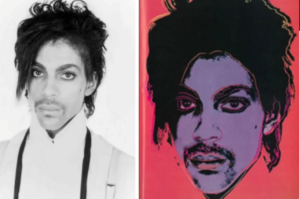
The U.S. Supreme Court is soon to rule on a case involving copyright issues that will have a big impact on artists who appropriate or remix existing images: Andy Warhol Foundation for the Visual Arts Inc v. Goldsmith, U.S. Supreme Court, No. 21-869. The U.S. Supreme Court must determine whether Andy Warhol sufficiently “transformed” photographer Lynn Goldsmith’s image of Prince when he made several unlicensed paintings to create the colorful “Prince Series.”
Whether Andy Warhol sufficiently transformed Goldsmith’s photo brings the complicated question of “fair use” in front of the court. A Manhattan judge determined Warhol’s work met fair use requirements because Warhol transformed Goldsmith’s “vulnerable” portrayal of Prince into an “iconic, larger-than-life figure.” On the other hand, U.S. Circuit Court of Appeals cited that a transformative work must have a “fundamentally different and new artistic purpose and character,” and concluded Warhol’s paintings to be “much closer to presenting the same work in a different form.” Even the U.S. government has become involved and has sided with photographer Goldsmith, with worries that Warhol’s supposed “transformation” of Goldsmith’s photograph would allow copy artists more freedom to appropriate existing works. The U.S. government has taken further action and has requestion the court to let it participate in an oral argument scheduled for Oct. 12, 2022.
The ruling the Supreme Court makes on the case will likely make a decisive definition as to what constitutes “fair use” within copyright law. This will likely be a major turning stone for many artists who rely on appropriated, ready-made, images for their work.
Find more information about copyrights and copyright resources here: www.madan-law.com/copyrights/
